|
Leg exercises often tend to be the least favorite part of workout
routines for many people. Often leg workouts are left for the end of
an exercise routine, or left for the end of the week, and then forgotten,
only to begin with upper body training the next week. The basic leg
muscles consist of
- quadriceps : on the front of the legs, needed for running, jumping,
and pushing
- adductor and abductor muscles: located on the inside and outside
of the legs, respectively, and are needed to move the legs together or
apart
- hamstrings: these muscles oppose the quadriceps, and help to kick the
leg back; the hamstrings and the quadriceps stabilize the knee
Important leg exercise tips:
- warm up first
- stretch before and after a leg workout
- don't lock your knees during the leg strengthening exercises;
this is cheating, and doesn't provide the full strain to the muscles you
are trying to strengthen; in addition, it can cause serious knee
injuries
Leg Extensions
Sit down with your butt and back firmly against the
seat. Adjust the pad by your feet so it is right above your ankles. The
starting position of your knees will be about at a 90-degree angle and the
finishing position is when you extend your legs out so that they finish in a
180-degree angle. Hold for a second and take them back to the 90-degree
angle. Hold on to the handles that are on the side of the seat so your butt
doesn’t come off of the seat.



Seated Leg Curl
Sit down with your butt and back flat against the seat.
Adjust the pad by your feet so it is on the backside of your ankles. The
starting position of your knees will be about at a 180-degree angle. Then
you will proceed to curl your feet towards your butt and your legs will
finish at about a 90-degree angle. Slowly lower the weight back up to the
starting position and repeat.

Leg Press
Sit down with your but and back flat against the seat.
Push the weight up and release the safety bars. The starting position is
when your legs are at about a 180-degree angle. However, if you go extremely
heavy use caution in locking your knees out. Next, you will proceed to lower
the weight down so that your legs will finish at a 90-degree angle. Do not
lower the weight lower than this because your lower back may start to come
off of the seat and this will cause lower back discomfort. Also, hold on to
the handles on the side of the seat so you do not start to slide off of the
seat.
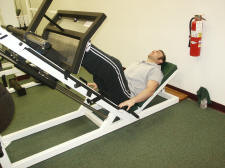
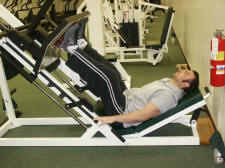

Seated Calve Raise
Sit down and adjust the pad so that you are just able
to get your knees under it and place the balls of your feet on the foot
support. Next raise your heels towards the ceiling as if you were standing
on your toes and release the safety support. Next you will lower your heals
towards the ground as far as you can the proceed to raise your heels back
towards the ceiling. When you are done make sure to put the safety bar back
before releasing the weight.
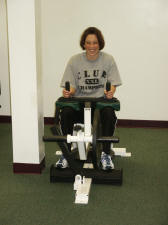
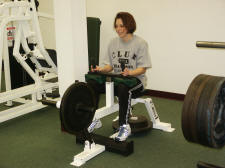
Body Weight Squat
Stand with feet about shoulder width apart or a little
wider and toes slightly pointed out. Have a chair or a bench directly behind
you. You will proceed to bend at your knees while lowering your butt to the
seat. Touch your butt to the seat but do not rest on it and stand back up.
It is important to keep your chest sticking out and stomach tight while
performing this exercise to take the pressure off of your lower back.
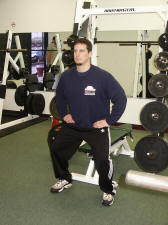 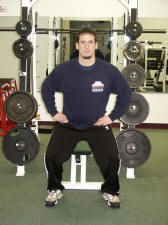 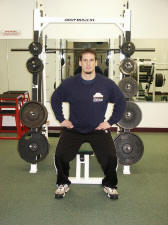
Stretching
Back Strengthening
Abdominals
Legs
Chest
Shoulders
Biceps
Triceps |

